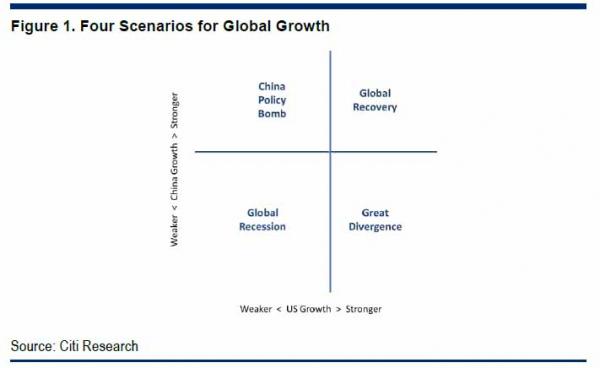![]()
Submitted by Tyler Durden on 09/14/2015 13:17 -0400
Of all the possible risk scenarios the meltdown scenario is, realistically speaking, the most likely to occur. It is actually a more realistic outcome than the capital stock adjustment scenario. The point at which the capital stock adjustment is expected to hit bottom is at a much lower point than in the previously discussed capital stock adjustment scenario (see Chart 8). As shown in the bottom right portion of this chart, the actual economic growth rate will continue to register considerably negative performance. If China’s economy, the second largest in the world, twice the size of Japan’s, were to lapse into a meltdown situation such as this one, the effect would more than likely send the world economy into a tailspin. Its impact could be the worst the world has ever seen.
We ended the post with the following rhetorical question: “now that Daiwa has broken the seal on Chinese and global doomsday scenarios, how soon other banks will follow in Daiwa’s path, and predict an Armageddon scenario which sooner or later, becomes a self-fulfilling prophecy even without the help of China’s increasingly clueless micromanagers.”
Today we got the answer: 48 hours – that’s how long it took Citi’s chief economist Willem Buiter to issue a report which was just as dire as Daiwa’s, but because Citigroup is much more reliant on keeping it traditionally bullish clients as happy as possible, one had to read between the lines to get to the bottom line.
This is Citi’s punchline: “A global recession starting in 2016, led by China is now our Global Economics team’s main scenario. Uncertainty remains, but the likelihood of a timely and effective policy response seems to be diminishing.“
Some of the other points from Buiter:
- China continues to dominate much of the current debate; specifically the extent to which the now well publicized economic slowdown could have wider contagion effects. Citi’s Global economics team, led by Willem Buiter, believes that China could be the driving force behind a global recession during the next two years.

- Last week we presented four scenarios based on different outcomes for Chinese and US economic growth. One of those scenarios; a global recession in which China’s slowdown drags other emerging markets and eventually the advanced economies down with it, has been examined in detail by our Global Economics team.
- Any global recession is likely to originate in emerging markets with China in particular at risk of a hard landing
- If the global economy slides into a recession of moderate depth and duration during 2016, it will most likely be dragged down by slow growth in a number of key emerging markets, and especially in China. We see such a scenario as increasingly likely. Indeed, we consider China to be at high and rapidly rising risk of a cyclical hard landing.
- There has been a long history in China of the official GDP data understating true GDP during a boom and overstating it during a slowdown. Citi’s own best prediction of ‘true’ real GDP growth for 2015 is 4% or less. Other activity indices overwhelmingly suggest an economy in which the growth of industrial production and capital expenditure is slowing rapidly.
- Recession in China and other EMs would likely slow DM growth too Should China enter a recession, with Russia and Brazil already in recession, we believe that many other EMs will follow, driven in part by the effects of China’s downturn on the demand for their exports and, for the commodity exporters, on commodity prices. We also consider it likely that, should the EMs enter recession territory, the advanced economies or developed markets (DMs) will not have enough resilience, either spontaneous or policy-driven, to prevent a global slowdown and recession. The large DMs may not experience recessions themselves but will likely grow more slowly; possibly more slowly than potential, and almost certainly more slowly than expected.
But why so much skepticism when central banks have historically done everything in their power to kick the can on the inevitable collapse, so far with passably successful results? Precisely that: Buiter now says tthat “the likelihood of a timely and effective policy response seems to be diminishing.”
The key for markets will be the policy response in China and, of course, the way in which DM central banks react to greater volatility, rising risk premia in asset prices and the implied tightening in financial conditions. Recent rhetoric still suggests that raising rates is still right in the middle of the Fed’s radar screen, but markets are suggesting that this may not be possible, with a September hike certainly being priced lower and lower. If the markets are right and there is an offsetting policy response to weaker equity and commodity markets, it will bring to mind parallels with 1998. This would suggest that it might be premature to turn too bearish on DM equities. If, however, EM growth concerns do spill-over to DM, we can envisage a time when we may want to reverse our preference for DM over EM, but that time is not here yet.
So, as expected, with Daiwa daring to first notice the ‘naked emperor’ the scramble to be next has been unleashed. Citi was first, who is next, and how soon until the market finally realizes that central banks are losing control of not only the economy and markets, but most importanly, the “confidence” narrative?
And as for the bigger question: how many months after the Fed hikes and unleashes said global recession, does the Fed unhike and launch QE4 or QE Air or QE Pro, or whatever Tim Cook advises Janet Yellen to call it.
